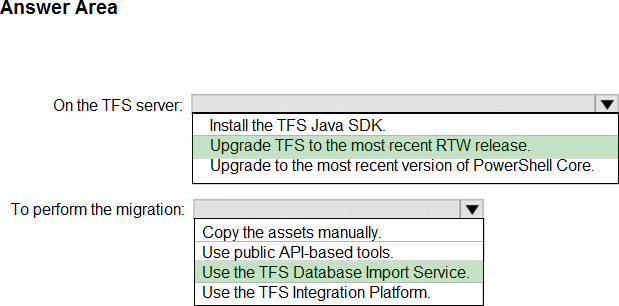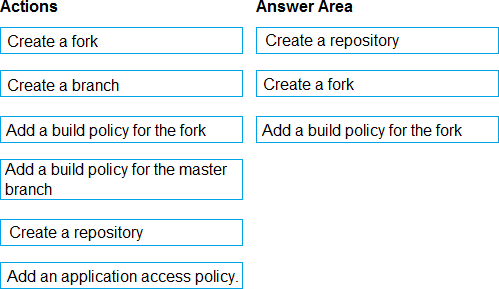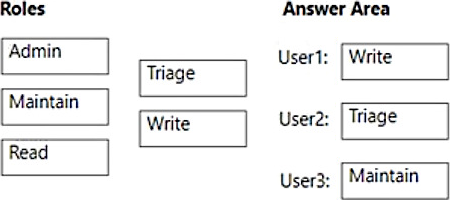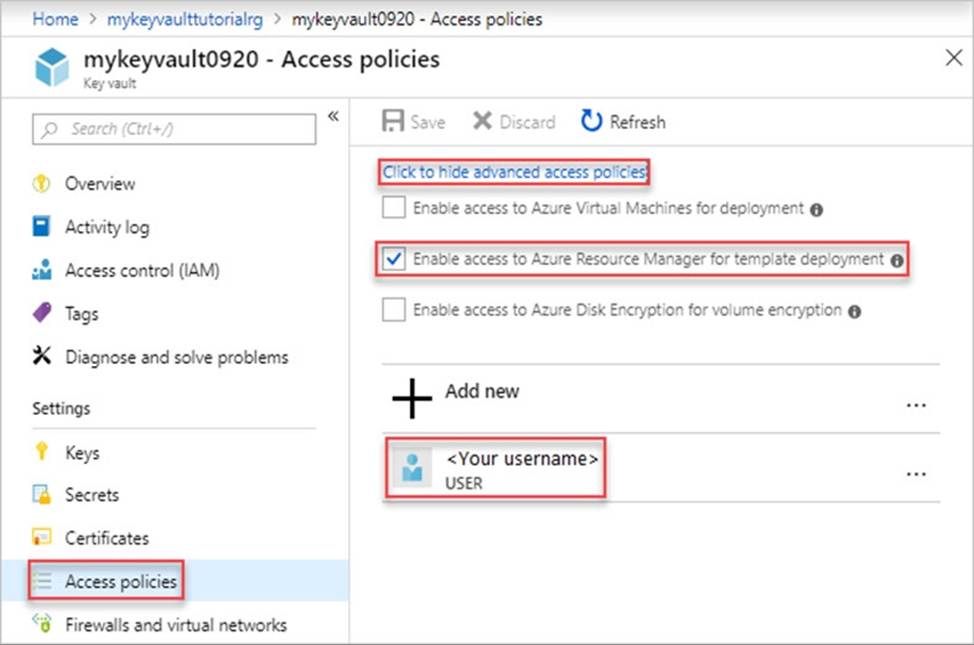Microsoft AZ-400 Übungsprüfungen
Zuletzt aktualisiert am 19.12.2025- Prüfungscode: AZ-400
- Prüfungsname: Designing and Implementing Microsoft DevOps Solutions
- Zertifizierungsanbieter: Microsoft
- Zuletzt aktualisiert am: 19.12.2025
You need to consider the underlined segment to establish whether it is accurate.
The Burnup widget measures the elapsed time from creation of work items to their completion.
Select `No adjustment required` if the underlined segment is accurate. If the underlined segment is inaccurate, select the accurate option.
- A . No adjustment required.
- B . Lead time
- C . Test results trend
- D . Burndown
HOTSPOT –
Your company uses Team Foundation Server 2013 (TFS 2013).
You plan to migrate to Azure DevOps.
You need to recommend a migration strategy that meets the following requirements:
✑ Preserves the dates of Team Foundation Version Control changesets
✑ Preserves the changes dates of work items revisions
✑ Minimizes migration effort
✑ Migrates all TFS artifacts
What should you recommend? To answer, select the appropriate options in the answer area. NOTE: Each correct selection is worth one point. Hot Area:
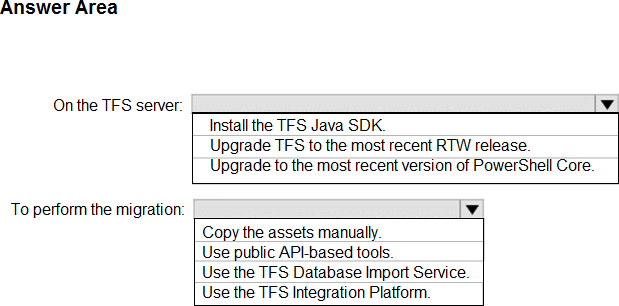
SIMULATION –
You plan to deploy a template named D: Deploy.json to a resource group named Deploy-lod123456789.
You need to modify the template to meet the following requirements, and then to deploy the template:
✑ The address space must be reduced to support only 256 total IP addresses.
✑ The subnet address space must be reduced to support only 64 total IP addresses.
To complete this task, sign in to the Microsoft Azure portal.
You have an Azure DevOps project that contains a release pipeline and a Git repository.
When a new code revision is committed to the repository, a build and release is triggered.
You need to ensure that release information for the pipeline is added automatically to the work items associated to the Git commit.
What should you do?
- A . Modify the Integrations options for the pipeline.
- B . Modify the post-deployment conditions for the last stage of the pipeline.
- C . Add an agentless job to the pipeline.
- D . Modify the service hooks for the project.
Introductory Info
Case Study
This is a case study. Case studies are not timed separately. You can use as much exam time as you would like to complete each case. However, there may be additional case studies and sections on this exam. You must manage your time to ensure that you are able to complete all questions included on this exam in the time provided.
To answer the questions included in a case study, you will need to reference information that is provided in the case study. Case studies might contain exhibits and other resources that provide more information about the scenario that is described in the case study. Each question is independent of the other questions in this case study.
At the end of this case study, a review screen will appear. This screen allows you to review your answers and to make changes before you move to the next section of the exam. After you begin a new section, you cannot return to this section.
To start the case study
To display the first question in this case study, click the Next button. Use the buttons in the left pane to explore the content of the case study before you answer the questions. Clicking these buttons displays information such as business requirements, existing environment, and problem statements. If the case study has an All Information tab, note that the information displayed is identical to the information displayed on the subsequent tabs. When you are ready to answer a question, click the Question button to return to the question.
Overview
Contoso, Ltd. is a manufacturing company that has a main office in Chicago.
Existing Environment
Contoso plans to improve its IT development and operations processes by implementing Azure DevOps principles. Contoso has an Azure
subscription and creates an Azure DevOps organization.
The Azure DevOps organization includes:
The Docker extension
A deployment pool named Pool7 that contains 10 Azure virtual machines that run Windows Server 2019 The Azure subscription contains an Azure Automation account.
Requirements
Planned changes
Contoso plans to create projects in Azure DevOps as shown in the following table.
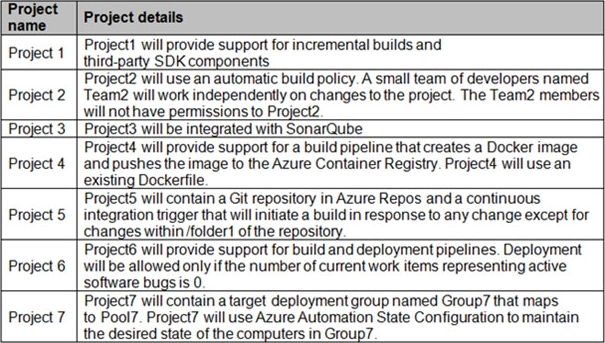
Technical requirements
Contoso identifies the following technical requirements:
Implement build agents for Project1.
Whenever possible, use Azure resources.
Avoid using deprecated technologies.
Implement a code ow strategy for Project2 that will:
– Enable Team2 to submit pull requests for Project2.
– Enable Team2 to work independently on changes to a copy of Project2.
– Ensure that any intermediary changes performed by Team2 on a copy of Project2 will be subject to the same restrictions as the ones defined in the build policy of Project2.
Whenever possible, implement automation and minimize administrative effort. Implement Project3, Project5, Project6, and Project7 based on the planned changes.
Implement Project4 and configure the project to push Docker images to Azure Container Registry.
DRAG DROP
You need to implement the code ow strategy for Project2 in Azure DevOps.
Which three actions should you perform in sequence? To answer, move the appropriate actions from the list of actions to the answer area and arrange them in the correct order.
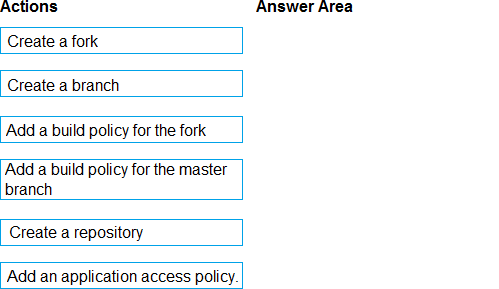
You have a project in Azure DevOps.
You create the following YAML template named Template1.yml.
steps:
– script: npm install
– script: yarn install
– script: npm run compile
You create the following pipeline named File1.yml.
parameters:
usersteps:
– task: MyTask@1
– script: echo Done
You need to ensure that Template1.yaml runs before File1.yml.
How should you update File1.yml?
- A . parameters: usersteps: extends: template: template1.yml – task: MyTask@1 – script: echo Done
- B . template: template1.yml parameters: usersteps: – task: MyTask@1 – script: echo Done
- C . extends: template: templatel.yml parameters: usersteps: – task: MyTask@1 – script: echo Done
- D . parameters: usersteps: – template: templatel.yml – task: MyTask@1 – script: echo Done
DRAG DROP
You have a GitHub organization that contains three users named User1, User2, and User3. You have a project that contains a repository named repo1.
You need to configure permissions for repo1.
The solution must meet the following requirements:
• Ensure that User1 can actively push to repo1.
• Ensure that User2 can manage issues and pull requests for repo1.
• Ensure that User3 can manage repo1.
• Prevent User3 from accessing sensitive data in repo1.
Which role should you assign to each user? To answer, drag the appropriate roles to the correct users. Each role may be used once, more than once, or not at all. You may need to drag the split bar between panes or scroll to view content. NOTE: Each correct selection is worth one point.

Note: This question is part of a series of questions that present the same scenario. Each question in the series contains a unique solution that might meet the stated goals. Some question sets might have more than one correct solution, while others might not have a correct solution.
After you answer a question in this section, you will NOT be able to return to it. As a result, these questions will not appear in the review screen.
You need to recommend an integration strategy for the build process of a Java application. The solution must meet the following requirements:
✑ The builds must access an on-premises dependency management system.
✑ The build outputs must be stored as Server artifacts in Azure DevOps.
✑ The source code must be stored in a Git repository in Azure DevOps.
Solution: Install and configure a self-hosted build agent on an on-premises machine. Configure the build pipeline to use the Default agent pool. Include the Java
Tool Installer task in the build pipeline.
Does this meet the goal?
- A . Yes
- B . No
DRAG DROP –
Your company has a project in Azure DevOps.
You plan to create a release pipeline that will deploy resources by using Azure Resource Manager templates.
The templates will reference
secrets stored in Azure
Key Vault.
You need to recommend a solution for accessing the secrets stored in the key vault during deployments. The solution must use the principle of least privilege.
What should you include in the recommendation? To answer, drag the appropriate configurations to the correct targets. Each configuration may be used once, more than once, or not at all. You may need to drag the split bar between panes or scroll to view content. NOTE: Each correct selection is worth one point.

Your company uses a Git repository in Azure Repos to manage the source code of a web application. The master branch is protected from direct updates.
Developers work on new features in the topic branches.
Because of the high volume of requested features, it is di cult to follow the history of the changes to the master branch.
You need to enforce a pull request merge strategy. The strategy must meet the following requirements:
✑ Consolidate commit histories.
✑ Merge the changes into a single commit.
Which merge strategy should you use in the branch policy?
- A . squash merge
- B . fast-forward merge
- C . Git fetch
- D . no-fast-forward merge

